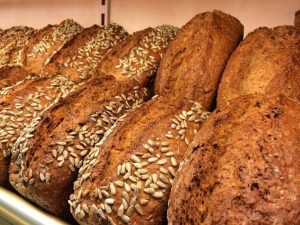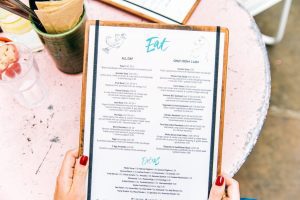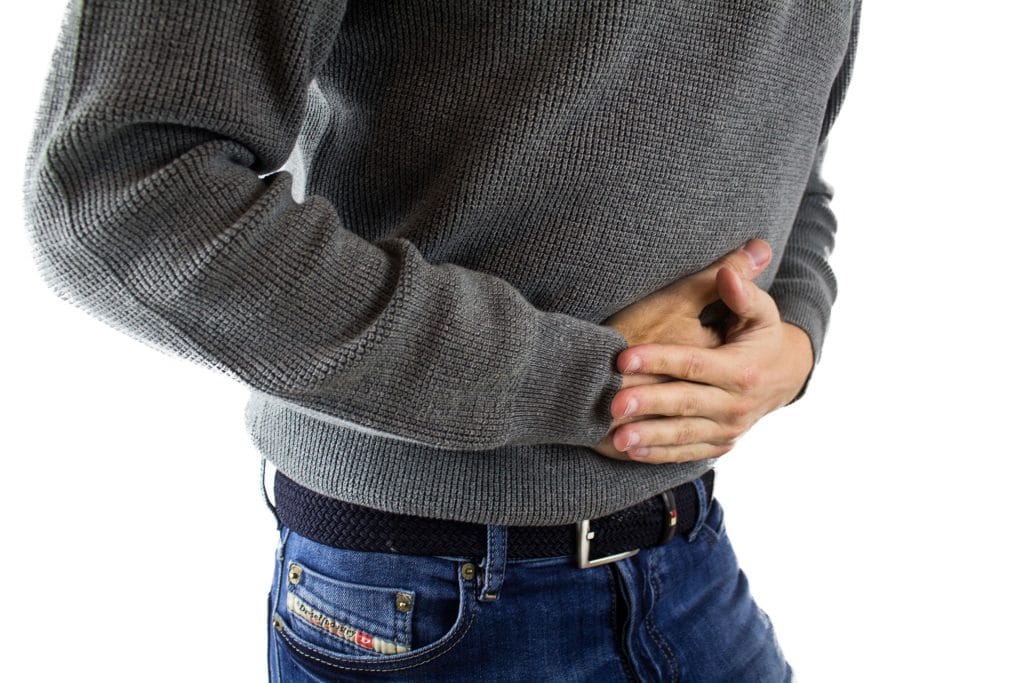There’s no denying that we all love gluten. What is gluten? We may not all know the answer to that question, but who among us hasn’t at one time or another had a hard time resisting the siren call of a pastry, a pizza, or a hot crusty roll? You’re probably craving one of them right now.
Sorry…

Back to the question: what is gluten? Why are gluten-free diets all the rage currently, and why are there so many celiacs among us these days? Why does the bread holding that amazing hoagie do things to me that it never seemed to do to my great-grandfather? There are answers to these questions.
Keep reading, and we’ll explore what gluten is, why some people can’t tolerate it, what it’s doing in the human body and the difference between gluten intolerance and celiac disease. We’ll look at what foods have gluten in them (including some that may surprise you), how to find hidden gluten on an ingredient list, and how to live long and prosper on a gluten-free diet.
So what is gluten? Let’s get right down to it.
What Is Gluten?

Gluten, specifically, is a protein. It is actually made up of two molecules: gliadin and glutenin. Gluten appears most famously in breads, and that’s because it is the gluten that make bread stretchy and delicious. The two molecules in question get elastic-y when you add water. It’s important to note that gluten is only one of many proteins in wheat.

If the word “gluten” seems familiar, that’s because it’s from the same Latin root as our word “glue.” If you’ve ever made bread, you know just how much like glue a glutinous bread dough really is.
This is why gluten is essential to bread-making and why it’s so difficult to make an excellent bread out of a gluten-free substance; though thankfully, it’s not impossible. All kinds of people are highly motivated to find a way to make gluten-free bread that is as close to the original as possible, and they’re getting better at it every year.
What Foods Have Gluten?

A little bit farther along we’re going to deal with the strange variety of foods that have gluten in them when you wouldn’t expect it, like candy, soy sauce, hot dogs, and salad dressings. Here we will just cover the foods that naturally have gluten. The main gluten-containing foods are grains.

Wheat varieties:
Farro
Durum
Spelt
Kamut,
White flour
Whole wheat flour
Bulgar
Semolina
Whole grains:
Barley
Triticale
Rye
Wheat byproducts:
beer,
crackers,
breakfast cereal,
wheat bran,
cookies, cakes, pastries, muffins, wheat germ, flour tortillas, croutons, graham flour, couscous, pasta
But Wait: Why Didn’t My Grandfather Ever Ask “What Is Gluten”?
Good question. There’s no denying that 100 years ago and more, people rarely worried about gluten or had a problem eating wheat or wheat byproducts. Celiac disease has been around since the time of Hippocrates (he for whom the Hippocratic Oath is named), but it’s never been a big issue until about half a century ago.
Wheat Has Changed
The bread that you’re eating today is not the same as the one your grandfather (or great-grandfather) used to eat. If that’s hard to believe, keep reading: but be warned. The next section contains both history and science, so if you want to run screaming away, now’s your chance.
But don’t. It’s important.
Early Wheat
Our ancestors first started harvesting a strain of wild grass about a few thousand years ago. As they began cultivating it, they developed close to 25,000 different strains, including the ancestor of what we call wheat: einkorn. Einkorn is quite simple and has just 14 chromosomes.
Wheat Cultivation
Being human, we love to experiment and make things better. We want food that grows well and resists pests and produces plenty of yield for the effort we put into it. Our farming ancestors combined einkorn with other wild grasses, combining genetic codes, and produced the next strain of wheat: emmer. This one had 28 chromosomes.
Emmer wheat is what people were mostly eating throughout the Middle East during Biblical times and is what was grown in Egypt and baked into the bread thrown to people in Rome when the emperors needed to buy some loyalty.
Further Changes
Over the next few centuries, emmer wheat mixed with yet another grass and gave us tritium aestivum wheat. That one had 42 chromosomes, and that was the wheat that human beings mostly ate right up until 50 years ago. That was the wheat your great-grandmother baked with, and your great-great-great-grandmother ate all the time without issue.
Saving the World
After World War II, our world faced an undeniable problem: hunger. The ravages of war and political instability throughout Asia, Europe, the Middle East, and North Africa threatened millions with starvation, and scientists in the United States were determined to find an answer.
With the best of intentions, they set out to create a wheat strain that would grow faster, in higher elevations and in more extreme temperatures, be more resistant to pests, need less water, and produce more yield per acre. No one is faulting them for that; and you shouldn’t, either.
What they did was to bombard wheat with radiation and splice the genes of the plant to produce mutations, combining the ones that were most useful. Each mutation was analyzed, and in the end, they succeeded. A geneticist by the name of Borlaug is credited with the final product, what is today called “dwarf wheat,” and his spectacular success literally saved the lives of millions.
Frankenwheat
The dwarf wheat that Borlaug created has a brand new genetic code different from the one in the wheat our ancestors ate. Dwarf wheat can never be grown organically, for example, because without chemical fertilizers and pesticides, it dies.
If you take a look at the proteins in this new wheat, 95% of them are the same as in ancient wheat. It’s the last 5% that are the problem. The biggest changes are seen in…
(wait for it)
…gluten! You guessed it. Gluten proteins in the now-ubiquitous dwarf wheat are very, very different from the gluten proteins in wheat our ancestors ate. To make matters worse, since Borlaug’s creation geneticists have continued to work on dwarf wheat, creating ever more changes.
Ok, But What Does That Mean?
If you’re worried about the question “what is gluten,” get excited; we’re now getting to the really relevant part. The changes in dwarf wheat’s gluten have changed the way human beings react to it.
For one thing, celiac disease has skyrocketed among populations that eat dwarf wheat. A study done by the Mayo Clinic looked at the blood of thousands of soldiers in the 1950s and compared it to the blood of thousands of soldiers taken in the late 90s. The researchers specifically looked at the presence of celiac antibodies and found them to be five times more common in modern soldiers than they were in soldiers 50 years ago.
Scientist magazine found that Denver children were developing celiac at three times the rate they had before, and that the prevalence of celiac in Minnesota had jumped from 0.2% of the population to 1% of the population less than 50 years. Something has changed, and the most likely culprit is gluten. What is gluten? Something that is harming us.
What Is Celiac Disease?
You can’t answer the question “what is gluten” without address the issue of celiac disease. Celiac disease is an autoimmune disease where the body attacks its own small intestine. The disease is triggered by gluten and improves when sufferers stop eating gluten.
The genetic structure of gluten is a bit similar to a protein that lives in our own bodies. In celiacs, the immune system gets confused about which is which, and, instead of attacking just the gluten, it attacks the body itself. Modern dwarf wheat gluten, unfortunately, is even more like our own protein than ancient wheat, so it’s more likely to kick off a celiac response.
Celiac Symptoms
What is gluten? It’s the stuff that makes celiacs experience an array of unpleasant symptoms, including:

Children and Teens:Growth problemsWeight lossChronic diarrheaConstipationVomitingBloating and painFatigueIrritabilityDepressionMouth soresItchy skinLate puberty
Adults:Unexplained iron deficiencyJoint painEarly onset arthritisTinging in hands or feetSeizuresMouth soresItchy skinGasConstant diarrheaExhaustionListlessnessWeight loss
Do All Our Bodies Attack Gluten?
Aha! Those logic classes are paying off! If you read that celiac’s bodies attack gluten and then have a bad response, you might be wondering why anyone’s body would attack gluten at all. The answer is that a substance in gluten damages the tight bonds in your intestines, allowing some gluten to slip through.
Now things should definitely not be slipping out of your intestine and into the rest of your body, so when they do your immune system very sensibly goes into attack mode. In most of us, this goes unnoticed; or we have the symptoms of “gluten sensitivity” (which we’ll go into in a moment). But in non-celiacs, the body recognizes the invader as an invader and leaves the rest of the proteins alone.
In celiacs, the immune system is being led by the biological equivalent of General Sherman, the “Butcher of Atlanta,” infamous for his behavior in regard to the people of Georgia and the Sioux Native Americans. The immune system won’t believe that the conflict is over and keeps looking for anything even remotely like the offending protein so it can kill it.
What Is Gluten Sensitivity?
Not everyone becomes a full-blown celiac in response to gluten, but a lot of people have problems with it nonetheless. Sometimes called a “gluten allergy,” gluten sensitivity hasn’t been well studied, but the people who suffer from it recognize it for what it is. When they eat gluten, they suffer certain symptoms. When they stop eating it, they feel better. The most common symptoms are:
You might experience gluten sensitivity symptoms when you eat rye and barley, too, but one of the problems with gluten sensitivity is that there is no test for it. To further complicate matters, some of the symptoms are similar to lactose intolerance and IBS.
So what should you do? If you’re experiencing any of the symptoms above, try going gluten-free for a month and see what happens. These days there are plenty of gluten substitutes, and many restaurants are aware of the need to protect people from gluten. It’s easier than ever to embark on a gluten-free diet. All you need to know is “what is gluten and how do I avoid it?”

What Else Does Gluten Do?
Some people avoid gluten even though they suffer none of these symptoms, and that is because wheat is particularly good at making us fat. It spikes the blood sugar, which in many of us signals to our body to grow the fat cells.
Dr. William Davis did a little self-experimentation to find out if modern wheat was worse than other grains or ancient wheat. He measured his blood sugar at intervals after eating einkorn wheat and after eating modern wheat.
The difference was dramatic. Modern wheat bread spiked his blood sugar higher and faster than even a candy bar and far faster than older wheat strains. This is one of the reasons that a gluten-free diet works pretty well in helping with weight loss (so long as you don’t just replace all the wheat with even greater quantities of gluten-free starches and sugars).
Is Gluten-Free Just a Fad?
There are always people who will do things just because their roommate’s yoga instructor Rain told them it was “awesome,” and who will then lose interest in it after a while. So in that sense, lots of things are just a fad when they begin. But many people see so many wonderful effects when they ditch the wheat that they stick with it for life. That can be you!
Tips for Starting a Gluten Free Diet
Now that you can answer “what is gluten” and know your enemy, it’s time to get to work on the solution. What is gluten in the real world; not just in theory but at the restaurant or grocery store?
Learn How to Identify Gluten
It’s not just enough to know how to identify a bagel or a piece of bread. You also need to know how to find hidden gluten on a product label. At the start of your transformation, you should get into the habit of reading every label closely: even on non-obvious food items.
Of course, you’re looking for anything labelled with wheat, barley, or rye. You’ll also want to watch out for these ingredients, which all contain gluten:
- Barley
- Bower’s yeast
- Bulgur
- Durum
- Farro
- Graham flour
- Hydrolyzed wheat protein
- Malt (extract, syrup, or flavoring)
- Malt vinegar
- Malted milk
- Matzo
- Modified wheat starch
- Oats or oat bran (unless specifically labelled gluten-free)
- Seitan
- Semolina
- Spelt
- Triticale
It’s worth knowing that many oats are processed on the same mills that process wheat, meaning that oats are normally heavily contaminated with gluten. Fortunately, producers now realize the problem, and it’s becoming increasingly easy to find gluten-free oats processed separately.
Checking for Gluten at the Supermarket
- Check the label to see if it specifically says “Gluten-free” If not, go on to step two.
- Go to the ingredients list and look for any of the items on the above list
- Since manufacturers don’t have to label rye or barley, if you are unsure, call the manufacturer or visit their website
Checking for Gluten at the Restaurant
- Call the restaurant and ask if they have a gluten-free menu
- When you arrive, ask to see the person you spoke with and be polite
- Take a look at the gluten-free menu
- If there is none, or if they assure you certain things can be made gluten-free, ask the waitress to tell you specifically what is ok to eat
- When in doubt, go with the items that have the fewest ingredients
- Always ask the server to verify that they heard “gluten-free” and again when the food comes out
The problem in restaurants is often cross-contamination, and that’s hard to control when you’re not cooking for yourself.
Fast-Food

Fast food is its own beast. One thing that’s important to know is that many fast food restaurants have no gluten protocol. If you ask them “What is gluten?” most people at the restaurant couldn’t tell you. If you order a burger without a bun, for example, there’s a high likelihood it will pass over surfaces where buns have been. If you order fries, they may be cooked in the same oil as battered chicken or hash browns. The fries might even have wheat in them.
There are some great fast food places with good protocols in place. We recommend In ‘N Out, Five Guys, and Shake Shack. Here’s what you need to do to get a good meal:
Announce Your Allergy
This way they know you don’t just want to eat low carb: they’ve actually got to change gloves, change table covers, and prepare your food completely away from gluten.
Listen for the Order to Be Repeated Back “Gluten-Free”
You want to make sure the person taking your order specifically repeats back to you that they heard your gluten allergy statement.
Ask the Server When Food Arrives
When your food comes out, make sure the server specifically mentions which items are gluten-free. If they forget, ask. If you’re ordering fast food, you should look for the gluten-free items to be in a completely separate container from those with gluten.
Ask About Fries
Most places with a good gluten-free protocol will cook their fries in a separate place from their gluten-covered friend chicken, mushrooms, or other items. Always ask just to make sure.
Safe Fast Food Without a Protocol
Celiacs and people with extreme sensitivities are probably best off sticking only to fast food places with a strict gluten protocol. However, if you are not overly sensitive or are eating gluten-free by choice, there are more options.
Arby’s
This is a great place to get gluten-free potato cakes and roast beef that never has to touch a bun.
Carl’s Jr.
Their Lo Carb Burger is gluten-free as are the regular and chili fries.
Sonic
Any of their burgers can be ordered without buns and will be pretty safe. The fries and tots are gluten-free, too.
Subway
You can manage here as long as you order salads. Most are gluten-free: just be sure to ask them for a list rather than assume that all salads are.
Wendy’s
Wendy’s fries are safe, and they can make most of their sandwiches without gluten as well. their salads come with croutons, but those are packaged separately, so they don’t have to be removed. Chili and baked potatoes are also gluten-free.
Fast-Food to Avoid
There are some chains that are less than friendly when it comes to catering to those avoiding gluten. Here are some you’ll want to avoid:
McDonald’s
Very, very little here is gluten-free. Even their hash browns and fries have wheat—though the amount is so little, it doesn’t bother many people. Burgers may or may not come in contact with wheat as they’re made, and many of the salad dressings have gluten.
Burger King
This one has the same problems as McDonald’s. They don’t have much in the way of gluten-free. However, their fries are safe, and some locations use a separate fryer for them. Just be aware that the hash browns are not ok, and that you’ll need to verify that your location does use a separate fryer.
Jack in the Box
Same problems as McDonald’s and Burger King.
Kentucky Fried Chicken
Nope. There are a couple of gluten-free sides. That’s all.
Taco Bell
You can get precisely three things here: a side of rice, side of rice with beans and cheese, or a tostada. Sorry, folks.
Of course, there are plenty more fast food and fast casual dining options out there. In fact, there are so many that it’s impossible to get all of them. If you’re just starting gluten-free, then stick with the bigger safe chains and branch out from there as you get your feet under you.
Foods With Gluten
It’s not good knowing “what is gluten” if you don’t know what foods contain it. Let’s go over the obvious culprits, the not-so-obvious culprits, and the “Are you kidding me?!” offenders.

Obvious:
Bread, pasta, crackers, pastries, pizza, cookies, biscuits, muffins, most breakfast cereals
Not-So-Obvious
Beer, ale, lager, broth, soup, chocolate bars, imitation bacon bits, imitation seafood, gravy, seasonings, soy sauce
Are You Kidding Me?!
Medications, sausages, hot dogs, sliced deli meat, marinades, salad dressing, flavored coffee, flavored tea, candies
Wheat starch thickens, so it’s frequently used in soups, broths, seasoning packets, and gravies. It binds things together, so it’s used in salad dressings, hot dogs, and sausages. You always, always have to check. As soon as you forget to check, you’ll come to grief.
The good news is that not all these items always have gluten. When we list salad dressings and chocolates on this list, that doesn’t mean you have to give up chocolate and salad dressing forever. It just means you have to hunt for the ones without gluten. There are gluten-free versions of everything on this list these days.
Get Family on Your Side
You want your family and friends to help, not hinder, you. Explain to them what you’re doing and why; and here’s the really important part: don’t talk like a crazy person.
If you sound off the wall, they won’t listen to you. What sounds weird? Avoid phrases like this:
- Big government is out to poison us all!
- Big agriculture is out to poison us all!
- Businesses don’t care if we all die! (Funny thing; killing off your customer base is something they teach you not to do in economics)
Stick to telling them you don’t feel well when you eat gluten and you’d love their help to stay away from it. If you don’t enlist their help, you’re liable to end up halfway through a “gluten-free” pie your Aunt Georgia made only to be told that she put a tablespoon of flour into it to thicken it because “it’s so little it won’t matter, right?”
Help your family learn what you can and can’t eat and be appreciative rather than demanding. Offer to bring a gluten-free item to dinner parties and other events. Don’t make people expend a lot of money or effort to accommodate you and they won’t get upset when you ask to check the seasoning packet ingredients before you eat dinner.
Learn What Foods Are Naturally Gluten-Free
There are plenty of foods that are naturally gluten-free, and if you know what they are you’ll see just how varied your diet can be. Here is a list:
- All fresh fruit
- All fresh vegetables
- Most cheese
- Most yogurt
- Most tortilla chips
- Rice
- Most spices
- Most herbs
- Most cream
- All butter
- All fresh, unprocessed meat
- All unflavored nuts and seeds
- Most taco shells
- Most ice cream
- Most frozen yogurt
- Some cheesecakes
- Most alcohol that isn’t beer
With some of these items, you’ll still need to check just to be sure. For example, all the individual spices and herbs that go into Mexican foods are gluten-free; but many taco seasoning packets have hydrolyzed wheat protein added.
As for alcohol, you’re usually safe unless you’re drinking beer, ale, or lager. Even some “gluten-free” beers cause people problems. You can safely drink most wines, ciders (check the label for gluten-free), and hard liquors.

That said, there are two things. Vodka made from potatoes is fine, but some is made from wheat. The same is true of some whiskey. Because these liquors go through a triple distillation process, they’re usually fine. Some very sensitive people, however, still have issues.
Find a Support Group

There are plenty of celiac support groups online and in your local area. These groups are a great source for recipes and information about gluten-free restaurants and grocery store items. Some food vendors market especially to members of these groups, and often they’ll let you taste things before you buy.
If you’re trying to do gluten-free with kids, you’ll find a support group especially helpful. The gluten-free life can be extra hard on children as they watch all their friends enjoy a pizza party or cake. The more you know about how to help them, the better.
Always Ask for Gluten Free Menu

Many restaurants have them now, and many are even up online. If a restaurant doesn’t have one or doesn’t seem helpful, or if you aren’t getting good answers to your questions when you ask a server, just walk away.
Clean Out Your Kitchen
You’ll be tempted to keep those glutinous items in the back just in case you ever need them. The problem is that you’ll “need” them tomorrow night at 10:00pm when you’re hangry and frustrated with the kids. Chuck it all. You can do it.
Keep a Food Diary
There are going to be some slip ups along the way. There are going to be some days when you “get glutened” and don’t know how it happened. If you’ve been keeping track of everything you eat, you’ll be able to track down the offending culprit and find out what is glutinous in what you’ve been eating.
Get Gluten-Free Versions of Your Favorites OR Go Cold Turkey
Your mileage may vary. Some people find it easiest to stick to a gluten-free diet if they find a satisfying gluten-free English muffin or pasta substitute. Others find that this method makes them crave their old foods even harder.
We recommend starting out by ditching anything that reminds you of the old foods at least until the worst of the cravings have passed. Once you’ve settled into a life without bread or any bread-like substitutes, you can start making gluten-free versions of your favorite foods without as much risk that you’ll wake up from a food coma next week in a dark alley surrounded by Krispy Kreme boxes.
Make a Meal Plan
Battles are won by the prepared. If you launch out into the gluten-free lifestyle without any preparation, you’re liable to fall hard. Your best bet is to plan out what you’re going to eat for a few weeks until you get into the groove.
Shop With a Friend

If you’re trying to go gluten-free, do your grocery shopping with another gluten-free person. The support will really help you make smart choices in those first few weeks.
Don’t Deny Yourself Other Things
In the first few weeks of your gluten-free diet, don’t worry about other foods. You may also want to cut down on your sugar, alcohol, fat, or processed food intake. In fact, you SHOULD. But if you’re really struggling to live without gluten, don’t deny yourself everything right at the start. It’s ok to have a glass of wine at dinner to get you through this period, and bacon guacamole is totally ok with us.
Meditate on What You’re Gaining
If you’re having trouble thinking only about those crispy-on-the-outside-chewy-on-the-inside bagels and can’t get past the loss, take some time to deliberately think about what you’re gaining. These foods aren’t your friends: they’re your enemies.
You’re gaining better skin, a better figure, more energy, better sleep, and no digestion issues, and less brain fog. That’s a lot to get in exchange for pizza.
Stock Up on Snacks
In the first few weeks, the cravings are going to hit hard. Now isn’t the time to stop snacking: load up on legal snacks that you can enjoy. You might not feel like eating them in the moment, but they will help with the gluten-craving; if only by making you feel full and less interested in eating.
Gluten-Free Snacks to Have on Hand
Popcorn
- Gluten-free cookie mix (or boxed cookies)
- Interesting cheese
- Gluten-free granola
- Gluten-free pretzels
- Chips (check for gluten on label)
- Gluten-free peanut butter or cheese sandwich crackers
- Honey glazed nuts
- Almond flour crackers
- Flavored apple chips
- Gluten-free cereals
- Flavored jerky
- Gluten-free gummies and sweets
- Frozen gluten-free pie crust
- Frozen french fries
- Frozen gluten-free pizza
- Gluten-free bread, bagels, or muffins
Once you’ve gotten past the initial stage, you’ll want to load up on some slightly healthier snacks. Hopefully. All the above-listed snacks are great, but they are also high in sugar and starch. Some are filled with interesting ingredients to make them hold together and behave like gluten—but eating enormous quantities of rice flour isn’t actually all that good for a person.
Once you have a handle on things, here are some healthy gluten-free snacks to have on hand:
- Strawberries and cream
- Blueberries and plain Greek yogurt (trust us)
- Raspberries and ricotta cheese
- Almonds
- Rolled ham slices with Emmental cheese
- Rolled roast beef slices with spicy cheddar cheese
- Small tomatoes stuffed with a mixture of cream cheese, chopped chives, and chopped bacon
- Chips and tzatziki
- Peanut butter and celery
- Toasted smoked mozzarella
Do Some Experimenting
You’re standing in the store, staring at a long line of backing products, wondering “what is gluten in here?” Most larger stores now have a huge gluten-free section, and you’ll find all kinds of gluten-free baking mixes and flours. There are so many that it’s overwhelming.
To start out, go with mixes from companies like Bob’s Red Mill. They do gluten-free porridges, three kinds of baking flour, cake mixes, pancake and waffle mix, cookie mixes, pie crust mix, shortbread: you name it.
Once you’ve found, say, a cake mix you love from one of these companies, take a look at the ingredient list. You’ll get an idea of what goes into them. Combine that with some recipes online, and you’ll soon be creating your own gluten-free baked goods.
Ditch Troublemakers
Is there a person in your life who just won’t leave you alone about your “crazy” diet choices? It might be time to let them go. Seriously. Think it over, and we’re not advising that you run off and burn all your bridges. But you need people in your life who will support and help you.
This is especially true if they would support you in something else. If you said you were going on a low-fat diet and insisted on getting fat free mayo and salad dressing and skimmed cheese, would they still give you a hard time?
Stick to It
Believe that you will get past the cravings: because you will! The cravings are awful while they last, but once they’re gone you’ll wonder what all the fuss was about in your head.
Gluten-Free for Life
For the first year or so, you might feel like a detective. You’ll be checking everything you put in your mouth and trying out new foods or new restaurants with great trepidation. At one point or another, you’ll wonder whether it’s all worth it.
Is it? What is gluten, and is it worth the aggravation to avoid? Don’t forget what you’ve learned; don’t forget what you’ve worked so hard to achieve. If you fall, don’t beat yourself up over it, but do notice how you feel. You won’t feel good: hang on to that terrible feeling and call it up the next time you’re tempted to reach for a pastry. the good life is worth so much more.
